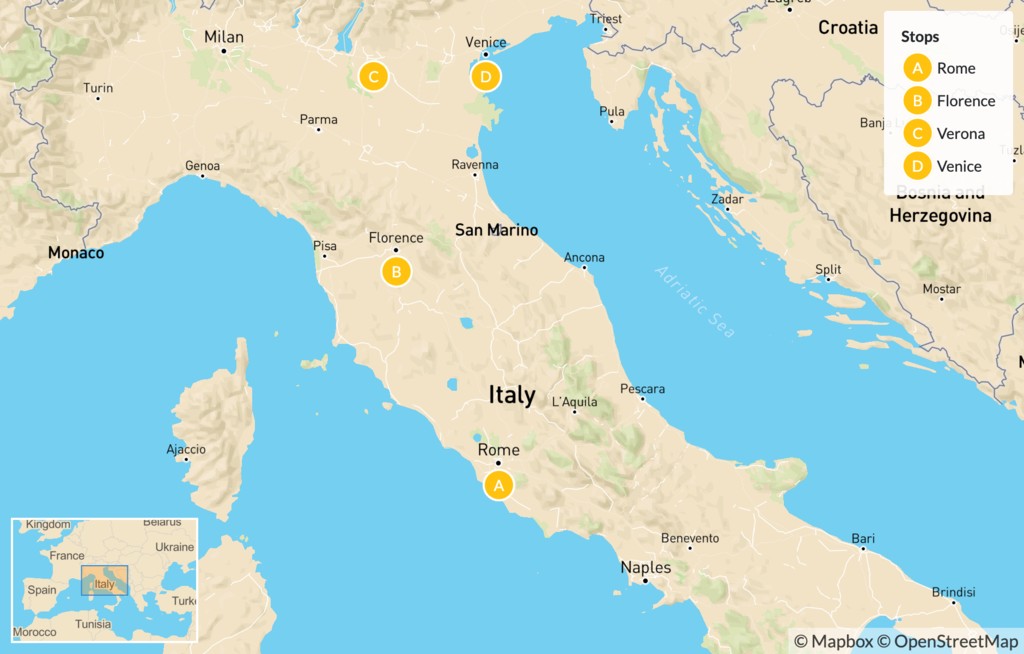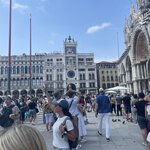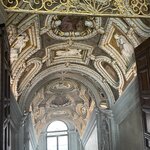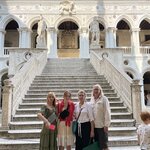Highlights
- Explore the world-famous Vatican Museums and Sistine Chapel with a guide
- Get a taste of local Rome with authentic markets and hip neighborhoods
- Join a Tuscan wine-tasting experience during your first evening in Florence
- Tour the romantic UNESCO-listed city of Verona and see Juliet's balcony
- Take a day trip to Venice and use the public water buses to get around
Brief Itinerary
| Day | Highlights | Overnight |
|---|---|---|
| Day 1 | Arrive in Rome, Explore | Rome |
| Day 2 | Self-Guided Visit the Colosseum & Roman Forum | Rome |
| Day 3 | Vatican Tour: Museums, Sistine Chapel & St. Peter's Basilica | Rome |
| Day 4 | Train to Florence, Evening Wine Tasting Experience | Florence |
| Day 5 | Florence Self-Guided City Tour | Florence |
| Day 6 | Train to Verona, Explore | Verona |
| Day 7 | Day Trip to Venice | Verona |
| Day 8 | Depart Verona |
Detailed Itinerary
Day 1: Arrive in Rome, Explore

Welcome to Rome! According to legend, Italy's capital was founded by brothers Romulus and Remus in 753 BCE atop Palatine Hill, which you'll have a chance to see tomorrow. As the longtime center of the mighty Roman Empire, you'll find nearly 3,000 years of architecture, history, and culture throughout the city. After arriving at one of Rome's airports, transfer to your hotel in the historic center. Settle in and then step outside for a stroll. The next few days will involve lots of sightseeing, so spend your first few hours enjoying some of the highlights at a relaxed pace.
You may want to start at the Catacombs of Priscilla, originally used from the second to fifth centuries as burial grounds for the elite families of Rome. Visitors can see the original structures as well as paintings and artifacts from various time periods. Or, simply stroll through the tangle of narrow streets in Centro Storico, one of Rome's most historic districts, to see beautiful fountains and classical Roman and Baroque architecture, including the Pantheon, a 2,000-year-old temple.
If you have energy left, walk to Colle Aventino, one of Rome's famous seven hills, and Parco Savello (Orange Tree Park), where you can find the renowned keyhole that gives a direct view of the Vatican. This is an excellent place to grab a cappuccino and snack from one of the adjacent cafés. For an authentic market experience, stop by the Mercato dei Fiori, where locals shop for fresh vegetables, flowers, meats, and cheeses. When it's time for dinner, head to the hip Trastevere neighborhood for some of the city's best trattorias.
Day 2: Self-Guided Visit the Colosseum & Roman Forum

Dive into the history of the Roman Empire today with a walking tour of the Colosseum, the world's largest amphitheater. Learn about the lives of some of ancient Rome's most famous and illustrious citizens, such as Julius Caesar, Emperor Augustus, Nero, and the Flavian Emperors who built the Colosseum.
From here, continue to the Roman Forum, where you'll see excavations dating back 2,000 years which reveal the ruins of temples, squares, religious sites, and other buildings. These were the venues for public speeches, processions, elections, and, of course, gladiator matches. Historians and archaeologists refer to the Roman Forum as the most celebrated place in world history, and you'll see why as you admire its grounds. You'll also cut through the Roman Forum along Via Sacra to pass by the Temples of Vesta, Antonino, and Faustina.
Your tour of ancient Rome ends 131 feet (40 m) above the city at Palatine Hill. Take in the incredible views of the city, with the Forum on one side, Circus Maximus on the other, and the Vatican in the distance. In the evening, continue exploring more of Rome on your own. Perhaps you want to grab dinner in one of the city's other neighborhoods, such as the bohemian Monti or upscale Prati, with an abundance of Art Nouveau architecture.
Day 3: Vatican Tour: Museums, Sistine Chapel & St. Peter's Basilica

After an early breakfast at your hotel, you can visit Vatican City's museums and other top sights during a three-hour guided morning tour. The Vatican is rich in history and art, housing some of the most important Renaissance masterpieces in the world. During the tour, you'll visit the Pio Clementio Museum, the Gallery of the Candelabra, the Gallery of Tapestries, and the Gallery of the Geographical Maps.
Continue through the museums to the Raphael Rooms, where you can admire the frescoes before entering the incredible Sistine Chapel and St. Peter's Basilica. Your guide will help you experience the allure of Renaissance art by divulging personal details and untold stories throughout the tour.
The rest of the day is free for you to explore on your own. Stroll through more of Rome's historical center to see iconic monuments and architecture, such as the Spanish Steps and Trevi Fountain. Then head over to Piazza Navona and admire the Fountain of the Four Rivers, designed by the iconic Italian sculptor Bernini. Finish your evening with a stroll through the piazza, stopping for pizza, gelato, and people-watching.
Chat with a local specialist who can help organize your trip.
Day 4: Train to Florence, Evening Wine Tasting Experience

After one last Roman breakfast at your hotel, transfer to the train station for your ride to Florence, the birthplace of the Italian Renaissance. Upon arrival, check into your hotel and then set out on foot. Florence is home to many masterpieces of Renaissance art and architecture, including the iconic Duomo, a terracotta-tiled dome, and the Galleria dell'Accademia, which displays Michelangelo's "David" sculpture.
You might want to start your exploration with a walk through the peaceful Boboli Gardens to see the oval-shaped Isolotto, a small island surrounded by various sculptures and lots of greenery. Visit the Chiesa e Museo di Orsanmichele, which served as the granary for the Sisters of San Michele in previous years.
In the evening, make your way to a local family-run wine bar, where you'll be guided through a tasting of wines that Tuscany is so known for. You'll learn about the culture and tradition behind each glass and the best way to pair and taste them. Enjoy an accompanying meal with your tasting in this intimate setting, all without leaving the city center of Florence.
Day 5: Florence Self-Guided City Tour

Today's exploration of Florence begins with a half-day walking tour. First, meet your guide and then stroll through the picturesque historic center, where you'll find the most important squares and monuments, from the Piazza della Repubblica to the Palazzo Vecchio. You'll then stop at the iconic Duomo, followed by visits to Giotto's Bell Tower and the Baptistery, with its bronze doors. Your guide will share stories of the famous Renaissance artists who called Florence home.
After your tour, continue exploring on your own. Consider taking a short walk over to the Mercato Centrale on the second floor of the Mercado di San Lorenzo, where you'll be able to meander through the stalls of local goods. If you're up for an uphill climb, cross over the Arno River to visit Piazzale Michelangelo (or take a taxi). This spectacular viewpoint offers an incredible view of all of Florence. It is the perfect place to watch the sunset before heading to Piazza Santo Spirito for predinner aperitivos.
Day 6: Train to Verona, Explore

Today you'll leave Florence and make your way up the Italian peninsula to the city of Verona, home of Shakespeare's famous love story. The train journey takes about three hours, with a stop in Bologna. When you arrive, make your way to your hotel to check in.
Take the rest of the afternoon to explore at your own pace. A good place to start is the Ponte Pietro, the historic arch bridge facing the San Giorgio in Braida Church. From there, venture up the stairs nearby to the Piazzale Castel San Pietro for a stunning view of Verona and a perfect place to watch the sun go down. This centuries-old fortress perched on a hilltop is an impressive architectural wonder in and of itself, but the view it gives of the city below is what makes it so special. Admire the church towers, river, and city skyline below before making your way back to the city center.
Finish the day at Piazza delle Erbe, where you can relax with dinner and a glass of wine amid your beautiful new surroundings.
Day 7: Day Trip to Venice

Take advantage of your geographic location today with a self-guided day trip to Verona's neighboring city, Venice. Just an hour away, frequent trains connect the two cities, so you'll have plenty of options to choose from. Once you arrive at the train station, use the city's vaporetto water buses that act as public transportation around the canals of Venice. Start at the center of it all in Piazza San Marco (St. Mark's Square). Take a moment to breathe in the sights and sounds of this famed square before getting a deeper look inside the impressive buildings and architecture that surround it.
Next, admire the impressive Basilica San Marco before exploring the interior and its incredible mosaics. If you're up for it, climb to the top of the campanile, the bell tower of the basilica that offers incredible views. From here, turn your attention to Doge's Palace, also located in St. Mark's Square. This almost 600-year-old building has served many purposes over the course of time but always continued to remain an impressive symbol of Venetian history. Then walk over to the Grand Canal side of the palace for a look at another iconic spot in Venice: the Bridge of Sighs.
Having seen the highlights of St. Mark's Square, it's time to make the 10-minute walk to Rialto Bridge, one of Venice's oldest and most well-known bridges, followed by the Rialto Market, an iconic food market that is buzzing with local life and flavors. From Venice's center, venture into the Cannaregio district, admiring the unique, iconic architecture. Cannaregio has plenty of artisanal shops to explore and not to mention a plethora of delicious restaurants and lively bars to stop in for dinner before heading back to the train station to head back to Verona for your last night.
Day 8: Depart Verona

Say goodbye, or ciao, to Italy for now! After breakfast at your hotel—and perhaps one more cappuccino—transfer to the airport for your connecting flight home. Safe travels!
More Great Italy Itineraries
Looking for more inspiration for your trip to Italy? Check out these other Italy itineraries, explore different ways to spend eight days in Italy, or discover the best time to visit Italy.








